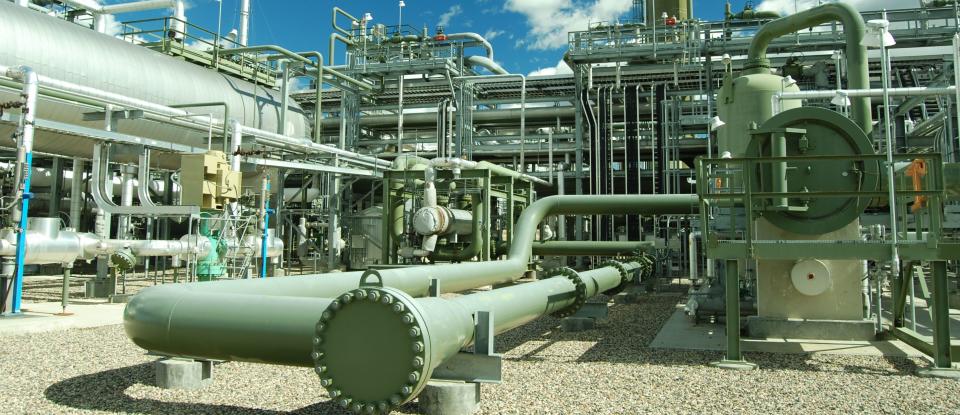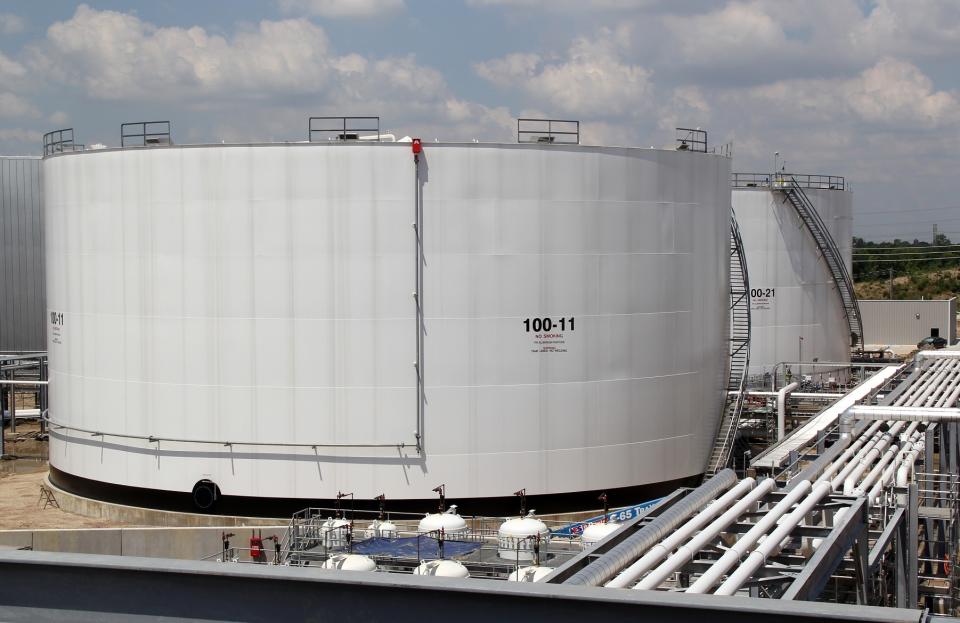The 10 Biggest Texas Stocks
Texas prides itself on its size, boasting big hats, big boots, big ranches, and big egos. The Lone Star State also has some of the biggest stocks in the market, and many investors have gotten rich by choosing the cream of the corporate crop that Texas has to offer.
The popular perception that many outside of Texas have of the state is that there's an oil well in every backyard. It's true that the energy industry has played a key role in the Texas economy for more than a century, and as you'll see below in the list of the biggest Texas stocks, many of the companies that have earned the biggest market capitalizations operate in the oil and gas industry. Yet with a more affordable standard of living, a surplus of open land, a multicultural community that draws people from throughout the Western Hemisphere and beyond, and a spirit of entrepreneurship and innovation, Texas has become a hotbed of enterprise in areas ranging from technology and trade to tourism and healthcare.
Here are the 10 biggest stocks whose headquarters are located in the Lone Star State.
The 10 biggest Texas stocks
Stock | Headquarters | Market Cap | 10-Year Total Return |
|---|---|---|---|
ExxonMobil (NYSE: XOM) | Irving | $320.4 billion | 51% |
AT&T (NYSE: T) | Dallas | $247 billion | 140% |
Texas Instruments (NASDAQ: TXN) | Dallas | $108.9 billion | 585% |
ConocoPhillips (NYSE: COP) | Houston | $67.9 billion | 182% |
Enterprise Products Partners (NYSE: EPD) | Houston | $63.5 billion | 301% |
Crown Castle International (NYSE: CCI) | Houston | $55.4 billion | 573% |
Schlumberger (NYSE: SLB) | Houston | $54.3 billion | (8%) |
EOG Resources (NYSE: EOG) | Houston | $50.8 billion | 190% |
Waste Management (NYSE: WM) | Houston | $49.2 billion | 486% |
Kinder Morgan (NYSE: KMI) | Houston | $47.5 billion | (8%)* |
Data source: S&P Global Market Intelligence. *Since February 2011.
Each of these 10 companies adds something important to the Texas economy. The way they and their smaller counterparts work together defines much of what gives Texas its reputation for being a business-friendly place.

Image source: Getty Images.
1. ExxonMobil
ExxonMobil has been a colossus in the oil and gas industry for decades. Exxon's history doesn't begin in Texas, as its origin dates back to the formation of Standard Oil by John D. Rockefeller in 1870. The oil giant decided to move its headquarters from Manhattan to the Dallas suburb of Irving in 1989, and Exxon's merger with Mobil in 1999 cemented its position atop the oil and gas industry.
As an integrated oil major, Exxon's operations span the full range of energy operations. From the upstream oil and gas exploration and production activities that discover and produce the energy products the world relies on, to midstream transportation of those products and downstream refining and marketing efforts, Exxon aims to profit from all of the opportunities its vast resource base offers.
ExxonMobil's lackluster stock return over the past 10 years reflects the volatility of the oil and gas industry. In addition, Exxon shares the difficulty that all large companies face in identifying and taking advantage of changing conditions in their respective businesses.
Yet Exxon hasn't hesitated to use its immense financial resources to seek out new opportunities for growth. The company is currently in the middle of a multiyear plan to boost its investment on new resources, with the intent of ensuring that its production levels will be able to grow even as existing assets are depleted. At the same time, Exxon hopes to play an even bigger role in refining and petrochemical production, putting to use the immense new reserves of oil in the U.S. to make value-added products and bolster profits. Even when crude oil prices have been under pressure, Exxon has been reliably profitable, and a dividend yield that has steadily risen from around 2% a decade ago to more than 4% as of this writing makes the stock even more attractive to income-seeking investors.
2. AT&T
AT&T has a similarly impressive history as ExxonMobil, with its origins dating back to the invention of the telephone. Originally established as Bell Telephone in 1879, the company that became AT&T was the most dominant telecommunications company of the 20th century until antitrust regulators forced it to break up. Regional Bell telephone providers were broken into separate companies, while AT&T continued to focus on long-distance services.
AT&T's Texas connection stems from merger and acquisition activity in the space. When long-distance phone services became so competitive that they stopped producing profits, regional carrier SBC Communications -- formerly Southwestern Bell -- bought AT&T and adopted the former giant's name.

Image source: AT&T.
Of course, AT&T has rediscovered prosperity in serving the wireless market as the nation's second-largest wireless carrier. As with the nationwide network of landlines that the company created early in its history, AT&T has invested huge amounts of capital in building and continually upgrading its wireless service. Most recently, the rise of 5G technology has signaled yet another expensive upgrade phase for the industry, and AT&T has had to respond to rising competition in the space by making sure it keeps up with quality improvements among its rivals.
Going forward, AT&T faces the challenge of balancing the prospects for all of its businesses. Although its legacy wireline services are in decline, exposure to areas like media content and cable television could produce new avenues for growth beyond broadband. An above-market dividend yield that has consistently remained in the 4% to 7% range over the past decade provides plenty of incentive for shareholders to hang onto their stock, but most hope that AT&T will be able to add more dramatic growth to lift its share price still further in the years to come.
3. Texas Instruments
For many investors, Texas Instruments' main claim to fame is its pioneering efforts to develop scientific calculators for the masses. It's hard to believe now, but scientists and engineers were once willing to pay the same amount for a TI calculator than you'd pay now to get a high-end smartphone with immense computing capability.
Like many Texas companies, Texas Instruments has roots in the oil and gas industry. The company started out as Geophysical Service in 1930. By the 1950s, though, the invention of the silicon transistor and integrated circuits put TI on the map. Over time, the company has adapted regularly to meet the changing needs of the technology industry.
Now, Texas Instruments has its fingers in a wide variety of industries. Its rugged products meet the needs of the aerospace and defense industry, and its expertise in making consumer goods has extended well beyond calculators to include computer and gaming peripherals. The semiconductor chips and other products TI makes go into mobile devices, data storage devices, and communications equipment for both consumer and industrial use.

Image source: Texas Instruments.
TI also remains on the cutting edge. In the automotive industry, the company is working on advanced driver assistance, as well as making improvements to entertainment systems and internal electronics. Facilitating the adoption of electric vehicles has also been a growth area for Texas Instruments.
This ability to keep growing has shown up in TI's stock price as well, making it the most successful stock on this list over the past 10 years. With continuing opportunities to keep profiting from advances in the tech field, Texas Instruments is positioned well to remain a leader in the Texas economy and across the tech industry.
4. ConocoPhillips
ConocoPhillips is another major oil and gas production company, with long roots in the Texas community. Conoco moved its headquarters to Houston in 1949, and when it merged with Phillips Petroleum in 2002, the combined company kept its home in the Lone Star State.
Throughout much of its history, ConocoPhillips was an integrated oil company. However, in the early 2010s, the company chose to spin off its midstream and downstream businesses into a separate company under the Phillips 66 (NYSE: PSX) name. ConocoPhillips held onto its upstream exploration and production business.
ConocoPhillips has worldwide scope, with assets in several key locations. Shale plays have grown in importance over the past decade, and Conoco's assets in the Permian Basin, Eagle Ford, and Bakken regions have fueled considerable growth in production and output. At the same time, the company also has significant projects in Alaska and has assets in Europe and across the Asia-Pacific region as well. It's those growth opportunities that have given the stock a superior return compared to the much larger ExxonMobil.
In the long run, the oil-price fluctuations that have troubled the energy sector for years aren't likely to stop ConocoPhillips from pursuing its broader strategy. Focusing its efforts on the assets that have the highest potential for growth while divesting its weaker-performing holdings has been a winning strategy during a tough period in the oil patch, and ConocoPhillips has been smart about dividing its capital among reinvestment in high-quality assets, buying back stock, and paying shareholders a dividend that has yielded around 2% to 2.5% over the past several years. Investors should be happy with how the oil giant is working to consolidate its best assets while still keeping an eye out for promising new assets when they become available.
5. Enterprise Products Partners
Enterprise Products Partners' history as a stock dates back to 1998, when the midstream master limited partnership first sold partnership units on the New York Stock Exchange. From there, the company made an extensive number of strategic acquisitions to bulk up its business. Enterprise now gathers, treats, processes, transports, and stores natural gas. It's also a major player in transporting and storing crude oil and natural gas liquids (NGLs), and it has the capacity to handle various petrochemical products and refined energy products as well.
Enterprise's assets within Texas are considerable. Several of its pipelines run within or through the Lone Star State, and the bulk of its NGL storage capacity is there, too. The MLP has more than two dozen natural gas processing plants, more than half of which are located in Texas, and more than three-quarters of its natural gas liquids fractionation capacity is there. Enterprise's marine terminals on the Houston Ship Channel are essential parts of its import and export capabilities, and crude oil terminals in Midland and Beaumont add to its Houston exposure.

Image source: Enterprise Products Partners.
Enterprise has plenty of ideas for continuing to build out its business, and Texas will play a key role. A new offshore crude oil port near Freeport could add to its international business, and the success of exploration and production companies in finding new resources in key plays like the Eagle Ford and Permian Basin could bring still more demand for pipelines and processing facilities.
Income investors love Enterprise and its MLP peers because of their high dividends, and Enterprise has maintained yields of 4% to 8% consistently over the past decade. Dividends have been an essential part of the growth in Enterprise's unit price over time, but there's still more opportunity for growth in the near future.
6. Crown Castle International
As we noted with AT&T above, the rise of broadband and wireless technology has revolutionized the way people across the globe use technology. In order to give consumers ubiquitous access to communications, there's a huge need for infrastructure assets like cellular towers and fiber networks. Crown Castle concentrates its efforts to build out that infrastructure, and the result has been immense growth in helping its clients provide their end customers with better service.
In particular, Crown Castle has cashed in on the rising demand for mobile data. Rental revenue from its towers and other assets has climbed at a healthy pace, and up to this point, most of those gains have stemmed from client efforts to flesh out their existing 4G networks in order to meet end-user needs.
The companies that turn to Crown Castle for help are only now starting to work on creating viable 5G wireless networks. That means Crown Castle hasn't even begun to see the positive impact on revenue and profit from customers seeking space for their 5G assets. Investors hope that the rise of 5G will be the driver for yet another long wave of growth for Crown Castle.
For shareholders, Crown Castle's structure as a real estate investment trust ensures that the company will pay out most of its profit to its investors as dividends. That's why the REIT's yield has been consistently between 3% and 4%, and there's every reason to think that the rising need for assets throughout the foreseeable future will only power Crown Castle's dividend higher.
7. Schlumberger
Many oil and gas investors focus primarily on the companies that actually drill wells and produce energy products. But behind every exploration and production player, there are countless companies that provide the materials, equipment, services, and expertise that go into making the most of the limited capital budgets that typical E&P companies have.
Schlumberger is a giant in the oilfield services business, and some would argue that it's not really fair to call the company a Texas native. As the correct pronunciation of its name suggests, Schlumberger was founded in France, and it has roughly 100,000 employees scattered across more than 85 countries around the world. However, the company dates its presence in Houston back to the 1930s, and after a stint in New York City, Schlumberger moved back to Texas for good in the mid-2000s.

Image source: Schlumberger.
Oilfield services stocks have had an especially difficult time over the past decade, as the decline in oil prices from well above $100 per barrel to much lower levels has had a dramatic effect on how much money Schlumberger's customers have to spend on capital expenditures. In particular, Schlumberger's capacity to provide expertise in deepwater operations, enhanced oil recovery methods, and unconventional resources make it the go-to choice when oil prices are high enough to justify extreme production measures. But when prices fall, producers typically fall back to more conventional and pedestrian methods, and that leaves Schlumberger with unused capacity.
After a couple of years of losses, though, Schlumberger has seen its work to become more efficient finally pay off. Even at somewhat depressed prices, the services company has returned to profitability and has solidly positive free cash flow. If the energy cycle turns back toward higher prices, then Schlumberger will be in a great position to serve its E&P clients with the premium services they need.
8. EOG Resources
The name Enron has become synonymous with corporate corruption and fraud, so it's interesting that the company once known as Enron Oil & Gas was quick to change its name once it became independent from its parent in 1999 -- well before the events that led to Enron's scandal and bankruptcy a couple years later. Yet the company has become an important player in the energy industry, with solid returns and a vast set of high-value assets.
EOG has an extensive presence in Texas, with assets in the Permian Basin, Eagle Ford, Barnett Shale, and Anadarko Basin areas, as well as smaller plays along the Gulf Coast and in the Ark-la-tex area. Yet EOG also has international scope, with key assets in China as well as the Caribbean nation of Trinidad & Tobago. You'll also find an EOG presence in the DJ Basin in northern Colorado, the Powder River Basin in Wyoming, the Williston region of North Dakota and Montana, and the Marcellus Shale along the Appalachian Mountain chain across Pennsylvania.
Even in a tough environment, EOG has worked hard to make the most of its opportunities. It's become more efficient with capital spending, finding top-quality assets and squeezing every barrel of production it can from them. An innovative spirit eschews acquisition-driven growth in favor of painstaking research to make new discoveries, and lower costs have given EOG an advantage over rivals that are more vulnerable to low oil prices.
EOG hasn't been a huge dividend payer, but more recently, the company has recommitted itself to income investors by boosting its payout by more than 70% in just over a year. The moves that EOG has made have put it in position to benefit from higher oil prices in the future.
9. Waste Management
Waste Management is a relatively new Texas company, having moved its corporate headquarters from Chicago to Houston in the late 1990s. The company got its start half a century ago, building on the legacy of one of its co-founders' ancestors, who had hauled wagon-loads of garbage in Chicago in the late 19th century. Now, Waste Management has become a leader not just in removing trash, but in putting it to better use with extensive recycling operations.
The trash business might seem completely unrelated to the energy industry, which is what most investors associate with Texas. However, more recently, Waste Management has opened up new opportunities that put it squarely in the energy business. The company has been a pioneer in using landfill gases to generate electricity, with much of that production going toward powering its fleet of specialty heavy-duty trucks. With the capacity to handle waste of all kinds and the scale to dominate the industry, Waste Management has become a leader in trash, recycling, and renewable energy generation.
Waste Management enjoys some significant barriers to competition that give it an edge. Because there's so much regulation in the handling of various types of waste, it can be difficult for upstart companies to get the approvals necessary to enter the industry. That helps to protect Waste Management from competition, and even though there are some other big players in the waste removal and recycling industry, the overall demand for services is large enough that these companies can divide up customers among themselves and still end up with considerable growth. Waste Management should remain the leading business in its namesake niche for the foreseeable future.
10. Kinder Morgan
Finally, Kinder Morgan is another Texas company with ties to the oil and gas industry. Like Enterprise Products Partners, Kinder Morgan specializes in energy infrastructure, with about 84,000 miles of pipelines and more than 150 terminal locations. The company transports natural gas, crude oil, gasoline, and other energy products as well as carbon dioxide and various chemicals.

Image source: Kinder Morgan.
Houston was Kinder Morgan's birthplace in 1997, with the entity originally getting set up as a master limited partnership. The MLP grew aggressively, and over the years, Kinder Morgan has gone through some transformative changes. Most recently, the company decided to give up the MLP structure and the attendant challenges related to investor accounting in favor of becoming a regular corporation, buying back units of various partnership entities that had given Kinder Morgan such a convoluted business structure.
In recent years, Kinder Morgan has gone through tough times. A 75% dividend cut made many shareholders lose faith in the energy company, and Kinder Morgan has had to take steps to become more efficient. Yet also assisting in the company's recovery has been more extensive activity in the areas that Kinder Morgan serves, especially the boom in shale drilling in the Permian Basin.
Kinder Morgan has big plans for the future, including its efforts to keep expanding to boost exposure to underserved areas both within and beyond Texas. As long as the energy boom in the U.S. continues, you can expect Kinder Morgan to keep helping oil and gas production companies get their products to market.
Don't mess with Texas
Texas is a big place, and the companies that call it home have a major impact on their respective industries. Between a huge presence in energy and the other sectors in which Texas companies have a large presence, investors can find a host of Texas stocks worthy of their consideration.
More From The Motley Fool
Dan Caplinger has no position in any of the stocks mentioned. The Motley Fool recommends Crown Castle International, Enterprise Products Partners, Kinder Morgan, and Waste Management. The Motley Fool has a disclosure policy.

 Yahoo Finance
Yahoo Finance 